Alaska Fish & Wildlife News
September 2023
American Marten
The torment of voles
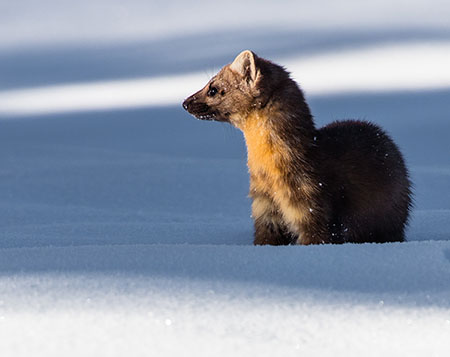
The winter of 2022—23 was memorable for many southcentral Alaskans. A series of weather events – heavy snowfall followed by windstorms followed by ice storms – shut down schools, businesses, and roads throughout the season. Like many of our neighbors, we hunkered down. But I hunkered down with uninvited guests: voles.
Voles in the walls. Voles in the ceiling. Voles in the crawlspace. A vole boldly ran through the living room while my cat, adorable though she may be, merely watched. For days the elaborate traps throughout my house remained empty. And then, just as quickly as the voles seemed to have arrived, they vanished. A few weeks later I learned why when a flash of movement in the trees caught my eye. An American marten (Martes americana), small and brown with rounded ears, stared back at me from its woody perch.
American marten are voracious weasels, and voles are a favorite prey. Gerrit Van Diest, a wildlife biologist with ADF&G, is studying marten in Southcentral Alaska. He confirmed that a sharp-eyed and hungry marten could have handily wiped out my vole infestation. He said voles can be so important to marten that vole abundance often dictates marten populations, similar to the snowshoe hare and lynx predator -prey relationship.
Van Diest is interested in another factor that could limit marten populations, and he’s collaborating with a group of Southcentral Alaskans with a keen interest in these agile carnivores, members of the Alaska Frontier Trappers Association.
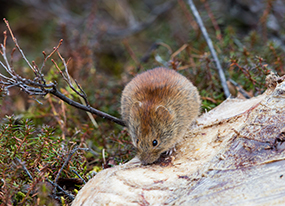
Marten are the most popular furbearer in Alaska, and typically between two and three thousand are harvested each year by trappers in winter months. The fur is known as sable, and generally brings between $1 to $2 million in revenue each year. Traps are often set in boxes off the ground, as marten spend a fair amount of time in trees. Much like cats, they’ll investigate boxes and containers and climb inside.
Marten belong to the versatile Mustelidae family that includes river and sea otters, ermine, mink, fishers, and wolverines. Marten have long narrow bodies and sharp, semi-retractable claws - good for climbing trees and grasping prey. Where otters are weasels adapted to an aquatic life, marten have adapted to a more arboreal life in forests. They hunt voles under the snow in winter, and take prey as large as hares, but they also hunt red squirrels in trees, and eat birds they can catch or eggs they can raid from a nest. They are opportunistic, scavenging wolf kills and spawned-out salmon carcasses, and will even eat seeds and berries in season.
American marten are found in forests throughout much of Alaska and Canada; in the Lower 48 they are typically called “pine marten.” A second species of marten, the Pacific marten (Martes caurina), is found on Admiralty and Kuiu islands in Southeast Alaska and in parts of the western US and Canda. The two species likely diverged during the ice age after being isolated from one another, and the Pacific marten colonized areas of the west as the ice sheets receded. Kuiu Island is the only place in Alaska where populations of the Pacific marten and American marten are known to interbreed and hybridize.
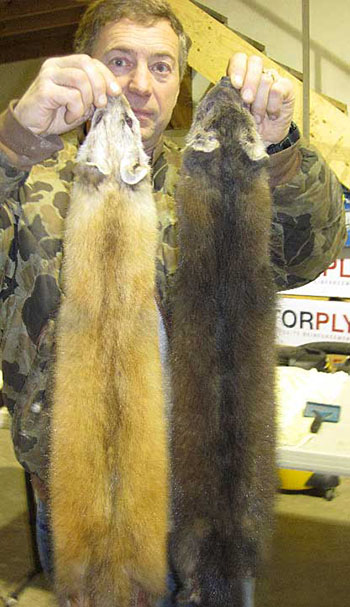
Baby marten are known as kits, and a female typically has three kits in a litter. Kits are often born and raised in tree cavities, holes in big trees that other cavity-nesting birds and animals use. It’s known that the availability of cavities for nesting sites can be a limiting factor for cavity nesting birds, and biologists and trappers in Canada suspected that might be true of marten as well. They wanted to see if marten would use artificial nest boxes, and if that could enhance the population. The results inspired Alaskans.
Van Diest said researchers in Quebec were looking at areas that had been logged - with a reduction in potential nesting sites. “A trapper’s association came up with the idea for the original study,” he said. “They wanted to provide artificial nest boxes, and they tried it. I don’t know if they had a significant difference, but marten did use the boxes. They had almost 50 percent occupancy.”
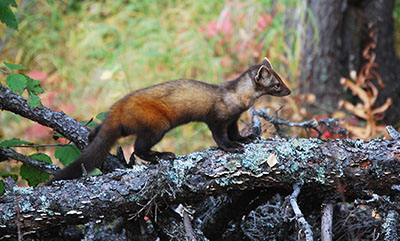
The Alaska Frontier Trappers Association raised money to fund the project in Southcentral Alaska and will build the shoebox-size nest boxes. “They want to do most of the legwork for it,” Van Diest said, “take the reins on the project, do track surveys and set up the boxes, and have this be their project with assistance from us.”
They postulate that marten populations are limited in part by nesting/denning locations and that by providing supplemental artificial nesting locations, marten populations will increase. They’ll set up two study areas, each with a corresponding control area, and conduct surveys of marten tracks in snow as an indication of marten abundance. Any vole and small mammal tracks encountered will also be documented.
The study areas will likely be traplines belonging to the trappers, ideally about 10 miles long, with the associated control area 10 or 15 miles away. Prior to marten “nesting” season, boxes will be placed in the study area/trapline every quarter or half mile, so between 20 and 40 nest boxes. Each box will be equipped with small hair traps to sample hair.
“We also might put some trail cameras out there to see if they’re using the boxes and nesting,” Van Diest said. “Ideally, one for every box, but 25 would be a decent number to shoot for.”
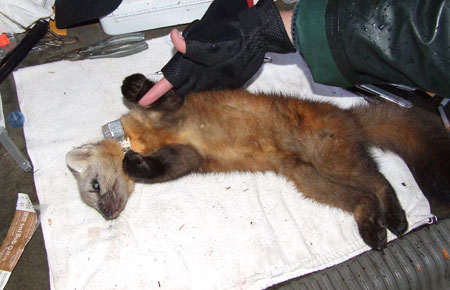
Trappers will record detailed information on every nest box location and tree, this will also provide insights into marten nesting. After nesting season, trappers will collect hair samples and document other evidence of use. Subsequent track surveys and marten harvest will provide more information.
Van Diest is looking forward to seeing the outcome – as well as the bigger picture regarding marten nesting. “The other things we are looking at – where exactly do they nest? What is the proximity to water, such as creeks or lakes. What kind of trees do they nest in, do they favor certain species or certain diameter? Do they change nesting locations from year to year, or do they re-use the same cavities?”
Work should begin this fall. A third study area (that won’t include the trapping component) is also being considered on Joint Base Elmendorf-Richardson, near Anchorage.
Learn more about marten and other members of the mustelid family
Want to learn more about marten and other Mustelids of Alaska?
American Marten species profile
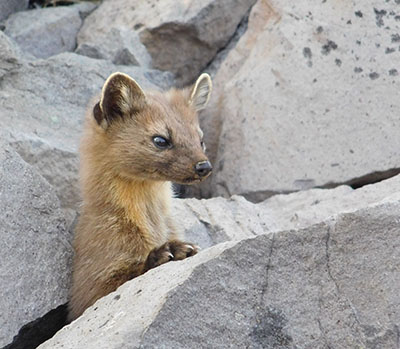
Pacific Marten species profile
Alaska Frontier Trappers Association
Marten trapping in Southeast Alaska
Parents and Teachers
Do you want to share more interesting tidbits and stories about mustelids with the kids in your life? Check out the next issue of Alaska’s Wild Wonders…The next issue of Alaska’s Wild Wonders Publication, A Mustelid Mystery will be released this fall. To catch the release of this issue, and more news from the Alaska Depart of Fish and Game, see the blue sign up box https://www.adfg.alaska.gov/index.cfm?adfg=wcnews.main and subscribe to the mailing list.
Furs of Alaska mammals - A teacher's guide
Subscribe to be notified about new issues
Receive a monthly notice about new issues and articles.
